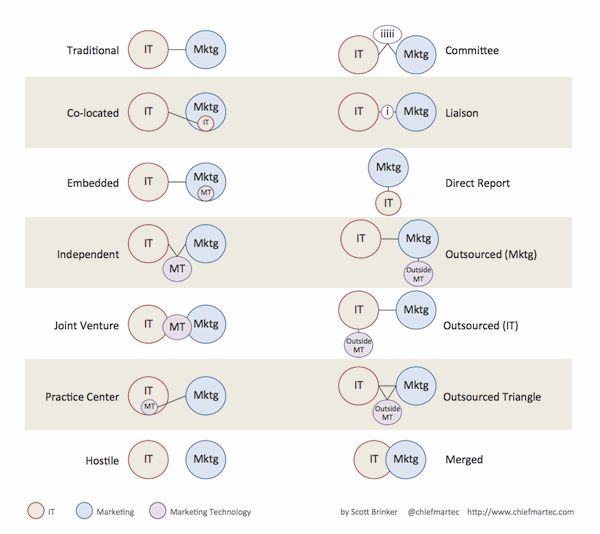The good news is that, at last, everyone agrees:
- Marketing technology is now a major dimension of marketing.
- The marketing department and the IT department must collaborate.
The challenge, however, is that beyond those two principles, there is a stunning diversity of opinions for how marketing technology should be managed and exactly what the new collaboration between marketing and IT should look like. I’ve heard from many different companies that are addressing this in very different ways.
At this stage, I actually think that’s fine. Different organizational structures should reflect different strategies and cultures — and often the individual leaders at the helm. What works great for one company might be a train wreck in another. What’s important, however, is that there is clear governance driving the choices in each particular company.
Are you consciously making your marketing-IT organizational decisions? Or do they just happen by “accident?” Of course, it helps to know what your choices are. With that in mind, I thought I’d try to assemble a list of the different marketing technology organizational models that I’ve encountered:
Here are brief descriptions of these models:
| Model | Description |
| Traditional | Marketing makes requests to IT, IT implements and manages overall technology strategy; funded via chargebacks to marketing and primary IT budget. Overall cycle speed usually slowed with overhead, differing priorities. Marketing unlikely to develop much technical savvy in this structure. |
| Committee | IT and marketing leaders, often including the CIO and CMO, participate in a committee to make joint decisions about marketing technology investments and governance. Usually IT handles implementation. Committees are rarely “agile,” but may provide good guidance. Committee members may become fluent in marketing-technology synergy. |
| Co-located | An IT team is dedicated to marketing technology and is physically co-located with the marketing team. Day-to-day execution is done collaboratively with marketing staff, but IT group still reports primarily to IT management (maybe dotted line to CMO). Helps exchange marketing and tech savvy across both departments. |
| Liaison | Similar to Committee structure, but an individual person provides coordination between IT and marketing, reporting jointly to CMO and CIO. Can be more agile. Role may be “Chief Marketing Technologist.” IT still handles most implementation, although outside vendors may be arranged by the liaison. |
| Embedded | A dedicated marketing technology team based in the marketing department — but unlike Co-located, reports to (and funded by) the CMO, not the CIO. Led by a Chief Marketing Technologist. Should still adhere to IT governance, may have dotted line accountability to CIO. May wear “marketing operations” label. Marketing becomes very tech savvy. |
| Direct Report | The IT department directly reports to the CMO. I’ve heard of a case of this with a major retailer. May work if marketing charter is broad enough to address the total customer experience. Seems tricky for non-marketing IT responsibilities. |
| Independent | An independent marketing technology team is assembled that lives outside of the traditional marketing and IT departments, although its chief reports to both the CIO and the CMO. Independence may enable agility, but possibly at the expense of alignment with the core departments from which it came. |
| Outsourced (Mktg) | The majority of marketing technology strategy and implementation is outsourced to one or more third-party vendors, but primarily under the direction of the CMO. Sidesteps as much IT implementation as possible with software-as-a-service (SaaS) and standardized APIs and data formats. Alignment concerns if third-parties are too strong relative to marketing’s own technical savvy. |
| Joint Venture | IT and marketing both contribute staff and resources to a joint “marketing technology” team, but the participants remain rooted in their origin department (unlike Independent). Can be quite agile and can cross-pollinate tech and marketing savvy across both departments. Requires good CIO-CMO synergy to work well. |
| Outsourced (IT) | Again, the majority of marketing technology strategy and implementation is outsourced to a third-party — but in this model, that’s done primarily under the leadership of the CIO. May be a different set of vendors than when outsourced from the marketing department. Runs the risk of diverging from core marketing vision. |
| Practice Center | IT creates a marketing technology “practice center” within its department to specialize in the growing tech needs of the marketing department. Possibly a dotted line report to the CMO. Can be quite agile. With the right dedicated hires and good communication with marketing can be a very marketing-savvy IT team. |
| Outsourced Triangle | Significant portions of marketing technology strategy and implementation are outsourced, but the outsourcing is jointly led by the CIO and the CMO. Requires good synergy between CIO and CMO to work. Growing number of agencies adept at this structure. Runs risk of not having marketing technology as an in-house core competency. |
| Hostile | The IT department and the marketing department are at best not speaking, at worst engaged in intracompany warfare. This is not a model anyone would want to adopt, but unfortunately it does accurately describe the state of some organizations. This is a terminal disease if it isn’t cured. |
| Merged | Some visionaries have suggested that IT and marketing should fully merge, more integrated than a Joint Venture or a Direct Report relationship. Loses independent IT governance. Mini-mergers with other departments, an IT diaspora? Viability depends on post-merger internal structure. |
Which organizational structure is right for your company? It depends.
Generally, I think that most companies should develop marketing technology competency internally — even if they choose to outsource certain pieces — and that marketing needs to become more technically savvy in order to properly lead the vision of customer experience and brand development in a digital world.
Many of the above models can accomplish those goals, although I think Embedded, Joint Venture, and Co-located (or Merged, if you believe that’s feasible) address those objectives better than the other configurations.
What do you think? What model is being used at your company? Are there other organizational structures that I should add to this list?




My agency works in all the variations of the Outsource MT models. We also operate in a fourth outsource variation that you might consider: working with the Internal MT as an outsourced advisor, guide, consultant, even implementer.
We have some clients where the internal MT knows what is required for success, but the marketing folks can’t deliver the technology and the IT folks, who might have the technical chops, don’t have the bandwidth for it.
This can be an ideal scenario actually, because the internal MT knows (and is trusted by) the organization, knows the technology, can set accurate expectations internally, can define requirements accurately for the external MT and create a smooth path to implementation.
In the absence of an IT team with the experience or resources to deliver, I think a great model would be the Joint Venture model with the Outsourced MT reporting into the Internal MT directly.
Thanks for this great diagram
Hi, Ed — thanks for sharing your experience with this from the agency side. Great suggestion about a hybrid of the Independent and Outsourced Triangle. I can see how that could be a powerful combination.
Overall, I think agencies, vendors and other third-parties have significant roles to play in *all* of these scenarios. In the case of the ones that I’ve explicitly labeled as “Outsourced”, I’m actually envisioning the third-party as the primary driver of marketing technology strategy and leadership.
In those cases, it probably also makes a difference if we’re talking about that being a transitional role (to eventually develop more native marketing technology savvy within the company), or a more permanent offloading of the responsibility to the third-party.
So many possible roads to enlightenment, eh?
Great job listing out the available models Scott. (I got a chuckle out of hostile.) I like how you highlighted the key elements to the model. You are truly correct in that the best model is “it depends”. JV seems very appropriate for my business but I know MTs at more technical organizations (software dev) where the Embedded model is the best fit.
As always, keep up the great work!
Fantastic post I have included it in our blog to be found here:http://blog.freedmaninternational.com/
Really great article and I love the way you have defined and explained the different models. It’s interesting to see where my organization sits in this grouping. Great stuff!
Very nice post, thank you. Within a large marketing group as a technologist, we dealing(fighting)IT on daily bases; our marketing technology group is a new group in Marketing organization and your clear description on different marketing/IT operation model really help us moving forward.
Great post, it reminds me of my struggles and triumphs (not often enough) to make marketing and IT organizations work towards a set of common goals. I have found that the day to day operational challenges often cause a lot of friction. I implemented Jira and adopted it to Marketing processes. It had mixed results, most of them related to project effort estimation.